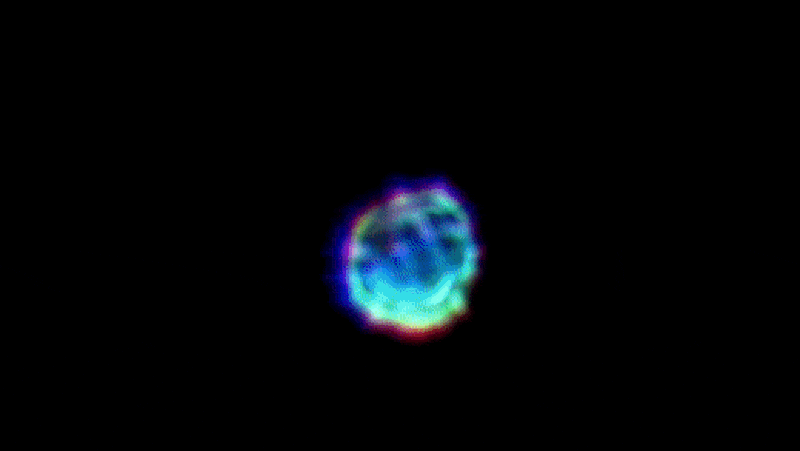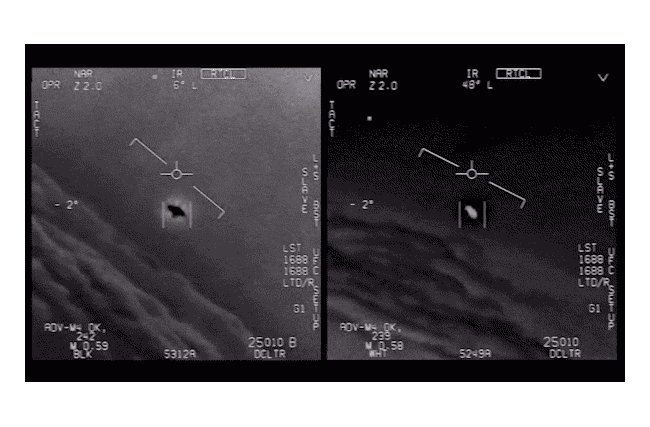Ask Ethan: Can science explain UFO sightings?

- Since even before the beginning of the space age, people have reported and even recorded “eyewitness accounts” of aerial or astronomical phenomena that seem to defy the laws of physics.
- But are any of these reports convincing or compelling enough to rule out natural or human-caused phenomena, or are they simply cases of people’s imaginations running wild?
- By popular request, an astrophysicist takes a look into a few specific claims and assertions, and tries to apply scientific reasoning to these extraordinary claims. Are you convinced?
When we look up at the skies, a myriad of sights can await us, but most of them don’t raise our hackles in any meaningful way. The stars, planets, and plane of the Milky Way have been common features in the night sky since ancient times, as well as a few faint, distant nebulae and galaxies, along with the occasional comet or spectacular meteor. More recently, terrestrial aircraft — such as blimps, planes, and helicopters — as well as space-age rockets and satellites have joined them in the sky, where they’re often visible to humans on the ground.
But every once in a while, there are reports that don’t appear to coincide with any of these known, easily explainable phenomena. People have seen, photographed, and sometimes even recorded sights of objects or lights that cannot be identified: objects known as either UFOs (unidentified flying objects) or UAPs (unexplained aerial phenomena). I, myself, even have direct experience witnessing one of these, and don’t have a wholly satisfactory explanation for it. But what about the experiences of others? That’s what Simon Tatt wants to know, pointing to a specific story in particular:
“Ryan Sprague has a podcast called Somewhere in the Skies. These are reports from people, recorded by themselves, in their own time and in a comfortable space… In my opinion they are quite fascinating. Especially the one from a gentleman who describes what he saw in the traffic one day. In my opinion, this man’s report sounds genuine. Can what he saw be explained by current scientific understanding?”
Let’s start with some claims from the past and establish what is and isn’t within the current realm of scientific understanding, and then let’s turn to this unique, singular story in particular.

What you see, above, is two images of the same patch of sky, imaged 46 years apart: a 1950 image from the Palomar Sky Survey on the left, and an image calibrated to have similar sensitivity and similar wavelength coverage to that survey in 1996 on the right. In the nine green circles are the locations of lights that appear in the 1950 image, but not anywhere else: not on any previous or later photographic images, and not in any modern surveys that see many orders of magnitude fainter. Even before the 1957 launch of Sputnik, these are some of the earliest recorded photographs of “lights in the skies” that have no clear explanation.
But there is an explanation that makes a lot of sense, if you’re familiar with 1950-era astronomy technology, and in particular with the technology of photographic plates. Like all objects on Earth’s surface, photographic plates occasionally get struck by cosmic rays: high-energy particles that hit Earth’s atmosphere and produce showers of “daughter” particles that make it down to Earth’s surface. These cosmic ray particles largely go unnoticed, but on a modern camera, will produce what’s known as a “hot pixel,” appearing as an artificial and temporary “blip” of light. But on an old-school photographic plate, they’ll produce a white point of light: something that looks indistinguishable from a star. In other words, these probably are not UFOs or any cosmic source of light; they’re probably daughter particles resulting from a cosmic ray strike that happened to be directed at this photographic plate at just the right time.

Above, you can see an interactive visualization expressed in terms of a “heat map” of UFO sightings, which you can navigate to and click on for the various reports that have been filed of what people had seen. You’ll notice three main things when you study this map, or, at least, I noticed three main things.
- Almost all of the “heat” from these heat maps coincide with large populations centers, places with airports, and/or places with military bases.
- Almost all of the eyewitness accounts refer to flashing, colored lights that appear low on the horizon.
- And where there are multiple eyewitness accounts of the same event, the descriptions are usually mutually inconsistent with one another, with people disagreeing on the shape, color, and motion of the objects in question.
The first of these is what you’d expect, and what I myself experienced: people tend to see things both where things are and where people are. But the second and third points suggest something very different to an astronomer familiar with what appears in the night sky. For example, I want to show you, below, a video that was taken of a strange, irregularly moving, color-changing object that was shared with me from someone who dared me to try and explain it.

What an odd sight, isn’t it?
Perhaps not. This is simply a 13-second video of Sirius, the brightest star in Earth’s night sky, taken when the star is close to the horizon. The distortions you see in the star’s position, color, and other properties is simply due to the turbulent, irregular air flowing through Earth’s atmosphere, and the effects of atmospheric distortion on the light that passes through it. This has been a known effect since ancient times, when none other than Ptolemy claimed that Sirius was in fact red, even though it’s known to be an intrinsically blue star.
The atmosphere, particularly where it’s “thickest” from any observer’s perspective (i.e., close to the horizon), is capable of causing color distortion, brightness distortion, and even position distortion, especially for stars but even for planets, on occasion. It’s no coincidence that the most commonly reported UFOs (or UAPs) include Jupiter, Mercury, Sirius, a variety of satellites (including Starlink and the International Space Station), and — most commonly of all — the brightest planet in Earth’s night sky: Venus.

But not every such sighting can be explained by something so simple. The object that I saw certainly couldn’t be, and the various “tic tac” UFOs released relatively recently by the US military certainly can’t be. Although I can’t definitively state what those particular objects were, the released footage pretty clearly indicates that they:
- were within Earth’s atmosphere, rather than in space beyond the confines of Earth,
- were moving rapidly, like an artificial aircraft, but not at Star Trek-level speeds: we’re talking hundreds or thousands of kilometers-per-hour, not ~100,000 kilometers-per-second,
- and were all observed in locations where military maneuvers routinely occur and large, significant military bases were extremely close by.
When a military pilot states, “It moved like nothing I’ve ever seen and nothing I’ve ever heard of,” I can’t help but think of how secretive the military is in general, and how surprising I find it that anyone who’s been involved with the proverbial “left hand” of the military thinks they have a clue as to what the military’s “right hand” is doing. We’re all free to draw our own conclusions as to what a snippet of video like the one below actually indicates, but when I hear someone in the military assert, “This couldn’t be an asset of the United States’ military,” I’m more likely to not only discount that evidence, but to question the credibility of the one making such a knowingly-underinformed assertion.

Which brings us to the story (starting at 28:08 in the video linked here) recounted that described, while driving in his car, finding a black balloon in the air that appeared to be descending toward traffic. The man told his wife about the balloon, and she said, “Aw, that’s just an airplane,” and he said, “No no no, not the airplane, the balloon out in front of us.” And she saw it, noting, “That’s weird.” As the balloon descended down toward the ground, amidst the traffic in front of them, it went right above a car in the left lane and stopped, right above the car’s roof.
He then states it “locked onto” the car, like it was tailing the car, and that it was unaffected by the wind or anything: matching the car’s speed of ~45-55 miles-per-hour, matched its movement going around turns, without any wobbling or notable effects from the wind. And then the “balloon” rose, straight up, without wavering in any way, and then moved over to the car next to it and did the same thing: descended, hovered over it, tailed it and matched its speed, and then again went straight back up into the sky, rising, and slowing down to what would be a “full stop” with respect to the Earth, allowing the traffic — including the driver recounting that story and his spouse — to pass underneath it.

He then said that they looked up, and saw what appeared to be — up close and in broad daylight — simply a solid, round, opaque black sphere. It was like it was just hovering there, with no engines, no exhaust, no wings, and no propellers of any type visible. After driving past it, they marveled, filled with fear, wonder, and awe, but not disbelief, at what they had seen.
After recounting their experiences and looking up their experiences on the internet, the closest thing they could find that matched up was a Japanese drone that was wrapped in a spherical mesh, but it was clearly different in a number of ways.
- The mesh was transparent, not opaque.
- Video footage of the drone showed that it moved with the air: wavering, rather than moving in perfectly straight lines.
- And the drone clearly had moving parts within it, whereas the opaque “balloon” he saw had none.
He called the police, and was scolded for attempting to pull a prank on them, with one officer stating, “Sir, there are things we do to protect you that you don’t know about,” and the discussion went nowhere. He even made a report to MUFON, which investigates UFO sightings, and was disappointingly told, “It must’ve been a black balloon.”

So, what can we make of this account?
Clearly, this isn’t something that’s a part of our common experience. Yes, there are drones that we see capable of staying aloft, and the typical speed of a drone is right around 45 miles-per-hour: the same speed that the cars were going, with many drones capable of exceeding the FAA limit of 100 mph for an unmanned aircraft system. But most of the drones that we see commercially, with quad rotors and a flat, wide body aren’t necessarily representative of all the drones that are out there.
For example, a quick search on my end readily revealed a very stable, smallish spherical black drone developed in Korea that looks almost spherical. The video, embedded below, clearly shows toward the end that although the inner workings of the drone are not particularly different from your average run-of-the-mill drone, just a few extraneous additions, along with a paint job, can create a stable, spherical drone with all of the horizontal and vertical motion capabilities you’d desire. I’m not saying “This is the exact drone” that the driver saw, but that these technologies clearly exist on Earth. Moreover, the video (below) is already 8 years old, clearly showcasing technology that existed at the time the earlier story was experienced.
This design is by no means unique, either. Here’s a black, spherical drone with full 360° camera capabilities. 3D printables have enabled concept designs for drones that look very similar to what was described for at least the past 6 years, and there are even DIY instructions out there for how to build your own working spherical drone. Plus, it’s a very simple task to simply add opaque panels or reinforcements to the outside of almost any such uncrewed aircraft. I’m not saying that “This is definitely what the person who saw these objects was seeing,” but I am stating that this type of technology that seemed so foreign to an unfamiliar observer not only is perfectly in line with the known laws of physics, but that it’s well within the limits of even civilian-accessible technology.
There’s a knee-jerk reaction that I tend to see from almost everyone who has an experience with something that’s technologically advanced and wholly unfamiliar to them: to claim that it’s either magic, supernatural, or alien in nature. But, as someone with a PhD in physics who has witnessed a great number of previously impractical technologies come to fruition and maturity — after all, several of the “futuristic” technologies from the original Star Trek and Star Trek: The Next Generation series have already been achieved and surpassed as of 2023 — what “the laws of physics” actually allow and admit is far, far greater than almost any layperson is familiar with.

Which is to say, if I were to sum it all up, I don’t disbelieve a single word of the story recounted on Sprague’s podcast. I think it happened, I think it happened fairly closely to what was described, and I think it’s a credible story. What I don’t think, however, is that it violated the laws of physics or leveraged any technology that hasn’t been developed by humans on Earth. Instead, I think it’s likely that it relied on a technology that the observers were wholly unfamiliar with, and what seemed like an “alien technology” or like a phenomenon that “violated the laws of physics” was simply either a military, police, or even a civilian piece of modern equipment that behaved in non-intuitive ways.
To be completely honest, it brings to mind the British science-fiction writer Arthur C. Clarke’s famous three laws.
- When a distinguished but elderly scientist states that something is possible, he is almost certainly right. When he states that something is impossible, he is very probably wrong.
- The only way of discovering the limits of the possible is to venture a little way past them into the impossible.
- Any sufficiently advanced technology is indistinguishable from magic.
Perhaps not only Clarke, but even Shakespeare, were right all along: there are more things in Heaven and Earth than are dreamt of in all of human philosophy. Whenever we find them, the proper course of action is not to disbelieve them, but to observe, study, and eventually understand them. There might be something alien or even supernatural out there in the Universe, but the aerial phenomena we’ve seen in the sky are almost certainly not evidence of either.
Send in your Ask Ethan questions to startswithabang at gmail dot com!





